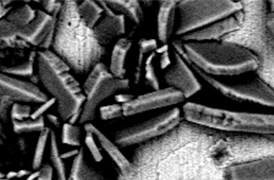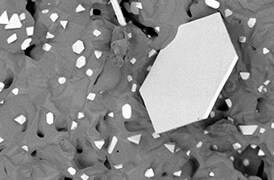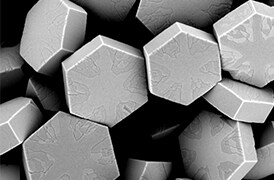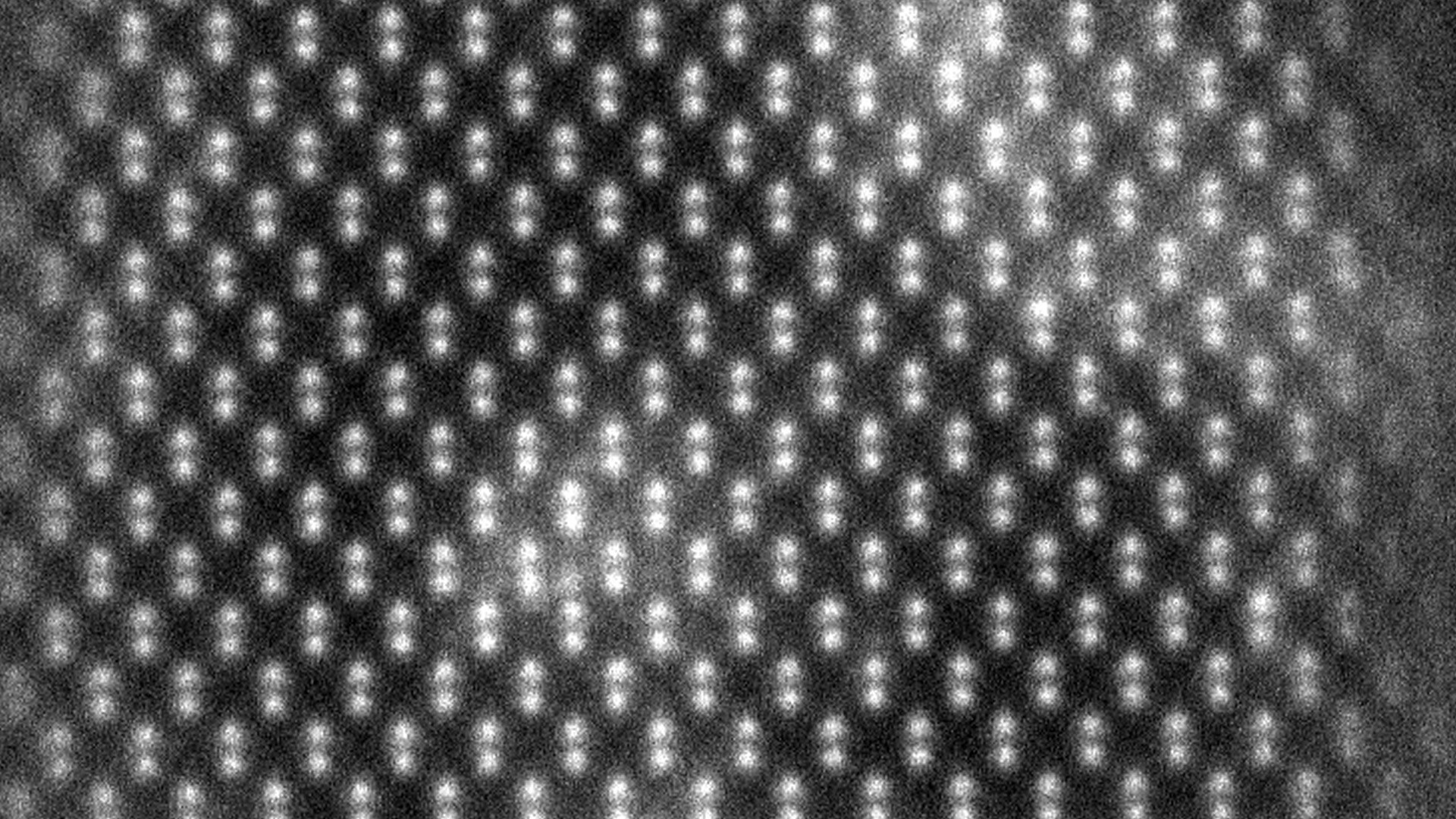Search Thermo Fisher Scientific
- Contact Us
- Quick Order
-
Don't have an account ? Create Account
Search Thermo Fisher Scientific
To truly optimize TEM and STEM imaging, EDX and EELS may require acquisition of different signals at different accelerating voltages. The rules may vary from sample to sample but, it is generally accepted that: 1) the best imaging is done at the highest possible accelerating voltage above which visible damage will occur, 2) EDX, especially when mapping, benefits from lower voltages with increased ionization cross-sections, thus yielding better signal-to-noise ratio maps for a given total dose, and 3) EELS works best at high voltages to avoid multiple scattering, which degrades the EELS signal with increasing sample thickness.
Unfortunately, acquisition at different accelerating voltages on the same sample without losing the region of interest—all during a single microscopy session—is not possible. At least, until now.
Imagine a Thermo Scientific Spectra 300 S/TEM:
With the new Spectra Ultra S/TEM, the accelerating voltage becomes an adjustable parameter, just like probe current, and the massive Ultra-X EDX system enables chemical characterization of materials too beam-sensitive for conventional EDX analysis.
The Spectra Ultra aberration-corrected S/TEM offers an industry leading level of characterization capabilities for materials science and semiconductor applications at the highest resolution on a wide variety of samples.
The Spectra Ultra S/TEM is delivered on a platform designed to offer an unprecedented level of mechanical stability quality through passive and (optional) active vibration isolation.
Like the Thermo Scientific Spectra 200 S/TEM and Spectra 300 S/TEM, the system is housed in a fully redesigned enclosure with a built-in on-screen display for convenient specimen loading and removal. For the first time, full modularity and upgradeability can be offered between uncorrected and single-corrected configurations with variable heights, allowing maximum flexibility for different room configurations.
The ability to switch accelerating voltage and achieve ultimate stability of the optics and specimen stage in less than five minutes provides unique capabilities and a new, faster way to operate the microscope to extract optimized information from your specimen.
This capability is achieved by the introduction of a radically redesigned objective lens that can operate at constant power for all accelerating voltages between 30 and 300 kV.
The constant power concept was pioneered with the introduction of the Titan TEM, formerly produced by FEI, over a decade and a half ago. It enabled mode switching at any given, but fixed, accelerating voltage without inducing drift because the objective lens thermal load would remain constant. Now, this concept has been extended to all voltage changes between 30 and 300 kV.
The objective lens produces magnetic fields that vary wildly depending on the mode and accelerating voltage. However, for the Spectra Ultra (S)TEM’s new objective lens, the thermal load remains constant at all times. The stabilization time of the optics and stage when switching between different accelerating voltages has been reduced from several hours to less than five minutes.
The benefits of accelerating voltage flexibility in combination with the Ultra-X detector are clear. Fast and flexible control over the HT, in combination with Ultra-X, opens the gateway to fast imaging at the highest resolution in combination with optimized STEM EDX analysis of beam-sensitive materials.
The Spectra Ultra S/TEM brings the next era in EDX detection to the market with our Ultra-X EDX detector. Providing a solid angle (>4.45 Sr) at least two times greater than any other EDX detector solution, the sensitivity of Ultra-X opens up new capabilities in STEM EDX analysis. Even with the shadowing of an analytical double tilt holder considered, the solid angle is >4.04 srad
The benefits of such high sensitivity are shown in the improvement in spectrum imaging quality with Ultra-X. A comparison using the same electron dose (8.28 x 108 e/Å2) is shown between Super-X, Dual-X, and Ultra-X on a DyScO3 specimen. The improvements in the signal-to-noise ratio shown in the raw data can be easily seen. Additionally, the oxygen lattice can be directly imaged with Ultra-X, where it could not with Super-X and Dual-X.
Additionally, the high sensitivity of Ultra-X means that the same level of chemical information can be obtained with a fraction of the electron dose that would be required for other EDX detector solutions. This opens up possibilities for STEM EDX analysis from more beam-sensitive specimens and faster mapping for more stable specimens.
STEM imaging on the Spectra Ultra S/TEM has been reimagined with the Panther STEM detection system, which includes a new data acquisition architecture and two new, solid-state, eight-segment ring and disk STEM detectors (16 segments in total). The new detector geometry offers access to advanced STEM imaging capability combined with the sensitivity to measure single electrons.
The entire signal chain is optimized and tuned to provide unprecedented signal-to-noise imaging capability with extremely low doses to facilitate imaging of beam-sensitive materials. Additionally, the completely redeveloped data acquisition infrastructure can combine different individual detector segments, with the future possibility of combining detector segments in arbitrary ways, generating new STEM imaging methods and revealing information that is not present in conventional STEM techniques. The architecture is also scalable and provides an interface to synchronize multiple STEM and spectroscopic signals.
The Spectra Ultra S/TEM is equipped with the new S-TWIN' (S-TWIN Prime) pole piece. The S-TWIN' is based on the S-TWIN design. It provides both ultra-high spatial resolution in STEM (e.g., 50 pm at 300 kV and 96 pm at 60 kV) and a wide gap for experiments requiring large tilt angles or bulky in situ holders.
The S-TWIN' differs in its ability to support an extremely high solid-angle EDX solution (see section on Ultra-X) without compromising spatial resolution. The S-TWIN', in combination with the enhanced mechanical stability of the base and the latest S-CORR probe corrector, matches the combined spatial resolution and combined high probe current specifications of the Spectra 300 TEM.
For a full list of these specifications—the highest commercially-available STEM specifications—please refer to the Spectra Ultra S/TEM datasheet.
X-FEG/Mono or X-FEG/UltiMono
The Spectra Ultra S/TEM can be optionally equipped with either a standard monochromator (X-FEG/Mono) or a high-energy resolution monochromator (X-FEG/UltiMono). Both monochromators are automatically excited and tuned with single-click operation to achieve the highest energy resolution possible on each configuration by using OptiMono or OptiMono+, respectively.
The X-FEG/Mono can be automatically tuned from 1 eV down to 0.2 eV, while the X-FEG/UltiMono can be automatically tuned from 1 eV down to <25 meV.
Both sources can be operated from 30 to 300 kV to accommodate the widest range of specimens. Both can also be run in standard mode, with the monochromators switched off, to accommodate experiments that require high brightness, including STEM EDS mapping, ultra-high-resolution STEM, or high total current, such as TEM imaging, all with no compromise to the other specifications of the system. This flexibility gives the Spectra Ultra (S)TEM the capability to function in settings where a large range of experiments are expected to be performed on one system.
OptiMono+ exciting an X-FEG/UltiMono from the monochromator off state (with 1 eV energy resolution) to the monochromator fully excited state (<30 meV) at 60 kV. (Data acquired on a Spectra 300 TEM.)
X-CFEG
The Spectra Ultra S/TEM can optionally be powered by a new cold field emission gun (X-CFEG). The X-CFEG has extremely high brightness (>>1.0 x 108 A/m2/Sr/V*), low energy spread (<0.4 eV), and can operate from 30 to 300 kV. This provides simultaneous high-resolution STEM imaging with high probe currents for high throughput, fast acquisition STEM analytics in parallel with high-energy resolution. With the powerful combination of X-CFEG and the S-CORR probe aberration corrector, sub-Angstrom (<0.8 Å) STEM-imaging resolution with over 1,000 pA of probe current can be routinely achieved.
Further, probe currents can be flexibly tuned from <1 pA up to the nA range with fine control of the gun and condenser optics, all with minimum impact on the probe aberrations, so that the widest range of specimens and experiments can be accommodated.
As with all cold field emission sources, the sharp tip requires a periodic regeneration (called flashing) to maintain the probe current. With the X-CFEG, the tip only requires flashing once per working day, a process takes less than a minute. There is no measurable impact on the probe aberrations even in the highest resolution imaging conditions, and the daily tip flashing process has no impact on the tip lifetime.
Tip flashing on the X-CFEG: 60 pm resolution at 200 kV is maintained before and after tip flashing without adjustment of the optics. The process takes <1 min, is required only once per working day, and has no impact on the lifetime of the tip.
This new generation X-CFEG also produces enough total beam current (>14 nA) to support standard TEM imaging experiments (e.g. in situ) with large parallel probes, making it a uniquely all-purpose, yet high performance, C-FEG.
Adding to the flexible nature of the X-CFEG is the capability to adjust the energy resolution by varying the extraction voltage.
In the example below, the energy resolution was adjusted between 0.39eV, with <500pA of probe current and 0.31eV, with >300pA of probe current. Maintaining high probe currents with high energy resolution allows for detailed analysis of Energy Loss Near Edge Structure (ELNES) analysis without the need for a monochromator on core loss edges. The spatial resolution, as demonstrated in the HAADF image of DyScO3, remains unaffected (in this case <63pA) which means that STEM EELS experiments with simultaneously high spatial resolution, energy resolution and signal to noise ratio can now be performed.
The lifetime of the tip is unaffected by the extraction voltage chosen to perform the experiment.
The Spectra Ultra S/TEM can be configured with an electron microscope pixel array detector (EMPAD) or a Thermo Scientific Ceta™ Camera with speed enhancement to collect 4D STEM data sets.
The EMPAD is capable of 30–300 kV and provides a high dynamic range (1:1,000,000 e- between pixels), high signal- to-noise ratio (1/140 e-), and high speed (1,100 frames per second) on a 128x128 pixel array, which makes it the optimal detector for 4D STEM applications (e.g., where the details of the central and diffracted beams need to be analyzed simultaneously, as in the following ptychography image).
More details can be found in the EMPAD datasheet.
The EMPAD detector can be used for a wide variety of applications. On the left, it is used to extend spatial resolution (0.39 Å) beyond the aperture limited resolution at low accelerating voltages (80 kV) in a bi-layer of the 2D material MoS₂ ( Jiang, Y. et al. Nature 559, 343–349, 2018). On the right, it is used to independently image dark field reflections, revealing the complex microstructure of the precipitates in a superalloy (Sample courtesy Professor G. Burke, University of Manchester).
The Ceta Camera with speed enhancement offers an alternative for 4D STEM applications where a greater number of pixels is required and when EDS analysis needs to be combined with each point in the STEM scan. This solution provides higher resolution diffraction patterns (up to 512 x 512 pixel resolution), suited for applications such as strain measurement.
The Spectra Ultra S/TEM accepts a wide range of holders for in situ experiments with its all-in-one S-TWIN’ wide-gap pole piece. The family of Thermo Scientific NanoEx Holders can be seamlessly integrated with the microscope, enabling MEMS device-based heating for atomic imaging at elevated temperatures. Below, gold nanoparticles are heated to 700 degrees Celsius and the resulting motion is captured simultaneously with full frame 4k by 4k pixel resolution at a rate greater than 30 frames per second on a Ceta Camera with speed enhancement. The result is high spatial and temporal resolution of highly dynamic molecular behavior.
On the left is a high frame rate movie of gold nano-islands at high temperature, collected on a Ceta Camera with speed enhancement. On the right, the 4k x 4k sensor allows digital zoom while maintaining high resolution in the field of interest.
(S)TEM, (scanning) transmission electron microscopy, and EDX, energy dispersive X-ray spectroscopy, are complimentary techniques that allow you to characterize the structural and chemical composition of materials down to the atom.
View our two-part on-demand webinar to learn about advances in (S)TEM and EDX that have enabled the analysis of the widest range of materials to date, including challenging samples such as beam-sensitive materials.
Uncorrected |
|
Probe corrected |
|
Probe+Image Corrected X-FEG/Mono |
|
Probe+Image Corrected X-FEG/UltiMono |
|
Probe+Image Corrected X-CFEG |
|
Source |
|
Tip flashing on the X-CFEG: 60 pm resolution at 200 kV is maintained before and after tip flashing without adjustment of the optics. The process takes <1 min, is required only once per working day, and has no impact on the lifetime of the tip.
On the left is a high frame rate movie of gold nano-islands at high temperature, collected on a Ceta Camera with speed enhancement. On the right, the 4k x 4k sensor allows digital zoom while maintaining high resolution in the field of interest.
(S)TEM, (scanning) transmission electron microscopy, and EDX, energy dispersive X-ray spectroscopy, are complimentary techniques that allow you to characterize the structural and chemical composition of materials down to the atom.
View our two-part on-demand webinar to learn about advances in (S)TEM and EDX that have enabled the analysis of the widest range of materials to date, including challenging samples such as beam-sensitive materials.
Tip flashing on the X-CFEG: 60 pm resolution at 200 kV is maintained before and after tip flashing without adjustment of the optics. The process takes <1 min, is required only once per working day, and has no impact on the lifetime of the tip.
On the left is a high frame rate movie of gold nano-islands at high temperature, collected on a Ceta Camera with speed enhancement. On the right, the 4k x 4k sensor allows digital zoom while maintaining high resolution in the field of interest.
(S)TEM, (scanning) transmission electron microscopy, and EDX, energy dispersive X-ray spectroscopy, are complimentary techniques that allow you to characterize the structural and chemical composition of materials down to the atom.
View our two-part on-demand webinar to learn about advances in (S)TEM and EDX that have enabled the analysis of the widest range of materials to date, including challenging samples such as beam-sensitive materials.
Modern industry demands high throughput with superior quality, a balance that is maintained through robust process control. SEM and TEM tools with dedicated automation software provide rapid, multi-scale information for process monitoring and improvement.
Quality control and assurance are essential in modern industry. We offer a range of EM and spectroscopy tools for multi-scale and multi-modal analysis of defects, allowing you to make reliable and informed decisions for process control and improvement.
Novel materials are investigated at increasingly smaller scales for maximum control of their physical and chemical properties. Electron microscopy provides researchers with key insight into a wide variety of material characteristics at the micro- to nano-scale.
Innovation starts with research and development. Learn more about solutions to help you understand innovative structures and materials at the atomic level.

Energy Dispersive Spectroscopy
Energy dispersive spectroscopy (EDS) collects detailed elemental information along with electron microscopy images, providing critical compositional context for EM observations. With EDS, chemical composition can be determined from quick, holistic surface scans down to individual atoms.
_Technique_800x375_144DPI.jpg)
3D EDS Tomography
Modern materials research is increasingly reliant on nanoscale analysis in three dimensions. 3D characterization, including compositional data for full chemical and structural context, is possible with 3D EM and energy dispersive X-ray spectroscopy.

Atomic-Scale Elemental Mapping with EDS
Atomic-resolution EDS provides unparalleled chemical context for materials analysis by differentiating the elemental identity of individual atoms. When combined with high-resolution TEM, it is possible to observe the precise organization of atoms in a sample.
_Technique_800x375_144DPI.jpg)
EDS Elemental Analysis
Thermo Scientific Phenom Elemental Mapping Software provides fast and reliable information on the distribution of chemical elements within a sample.

Electron Energy Loss Spectroscopy
Materials science research benefits from high-resolution EELS for a wide range of analytical applications. This includes high-throughput, high signal-to-noise-ratio elemental mapping, as well as probing of oxidation states and surface phonons.

In Situ experimentation
Direct, real-time observation of microstructural changes with electron microscopy is necessary to understand the underlying principles of dynamic processes such as recrystallization, grain growth, and phase transformation during heating, cooling, and wetting.

Particle analysis
Particle analysis plays a vital role in nanomaterials research and quality control. The nanometer-scale resolution and superior imaging of electron microscopy can be combined with specialized software for rapid characterization of powders and particles.

Multi-scale analysis
Novel materials must be analyzed at ever higher resolution while retaining the larger context of the sample. Multi-scale analysis allows for the correlation of various imaging tools and modalities such as X-ray microCT, DualBeam, Laser PFIB, SEM and TEM.
Semiconductor TEM Imaging and Analysis
Thermo Scientific transmission electron microscopes offer high-resolution imaging and analysis of semiconductor devices, enabling manufacturers to calibrate toolsets, diagnose failure mechanisms, and optimize overall process yields.

The Automated NanoParticle Workflow (APW) is a transmission electron microscope workflow for nanoparticle analysis, offering large area, high resolution imaging and data acquisition at the nanoscale, with on-the-fly processing.

Energy Dispersive Spectroscopy
Energy dispersive spectroscopy (EDS) collects detailed elemental information along with electron microscopy images, providing critical compositional context for EM observations. With EDS, chemical composition can be determined from quick, holistic surface scans down to individual atoms.
_Technique_800x375_144DPI.jpg)
3D EDS Tomography
Modern materials research is increasingly reliant on nanoscale analysis in three dimensions. 3D characterization, including compositional data for full chemical and structural context, is possible with 3D EM and energy dispersive X-ray spectroscopy.

Atomic-Scale Elemental Mapping with EDS
Atomic-resolution EDS provides unparalleled chemical context for materials analysis by differentiating the elemental identity of individual atoms. When combined with high-resolution TEM, it is possible to observe the precise organization of atoms in a sample.
_Technique_800x375_144DPI.jpg)
EDS Elemental Analysis
Thermo Scientific Phenom Elemental Mapping Software provides fast and reliable information on the distribution of chemical elements within a sample.

Electron Energy Loss Spectroscopy
Materials science research benefits from high-resolution EELS for a wide range of analytical applications. This includes high-throughput, high signal-to-noise-ratio elemental mapping, as well as probing of oxidation states and surface phonons.

In Situ experimentation
Direct, real-time observation of microstructural changes with electron microscopy is necessary to understand the underlying principles of dynamic processes such as recrystallization, grain growth, and phase transformation during heating, cooling, and wetting.

Particle analysis
Particle analysis plays a vital role in nanomaterials research and quality control. The nanometer-scale resolution and superior imaging of electron microscopy can be combined with specialized software for rapid characterization of powders and particles.

Multi-scale analysis
Novel materials must be analyzed at ever higher resolution while retaining the larger context of the sample. Multi-scale analysis allows for the correlation of various imaging tools and modalities such as X-ray microCT, DualBeam, Laser PFIB, SEM and TEM.
Semiconductor TEM Imaging and Analysis
Thermo Scientific transmission electron microscopes offer high-resolution imaging and analysis of semiconductor devices, enabling manufacturers to calibrate toolsets, diagnose failure mechanisms, and optimize overall process yields.

The Automated NanoParticle Workflow (APW) is a transmission electron microscope workflow for nanoparticle analysis, offering large area, high resolution imaging and data acquisition at the nanoscale, with on-the-fly processing.



















